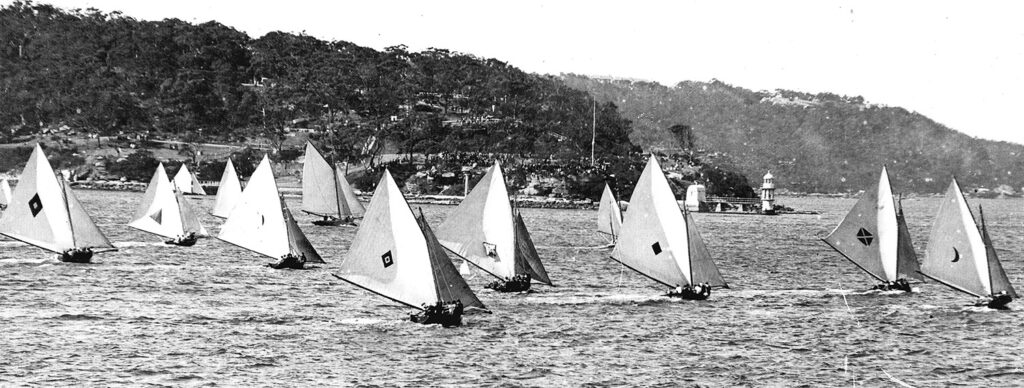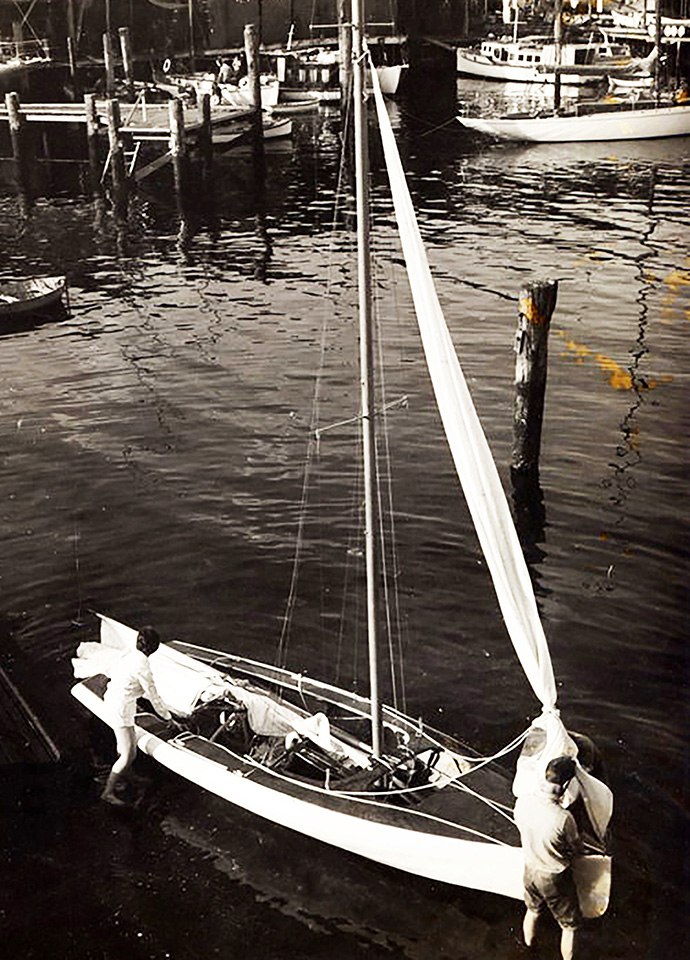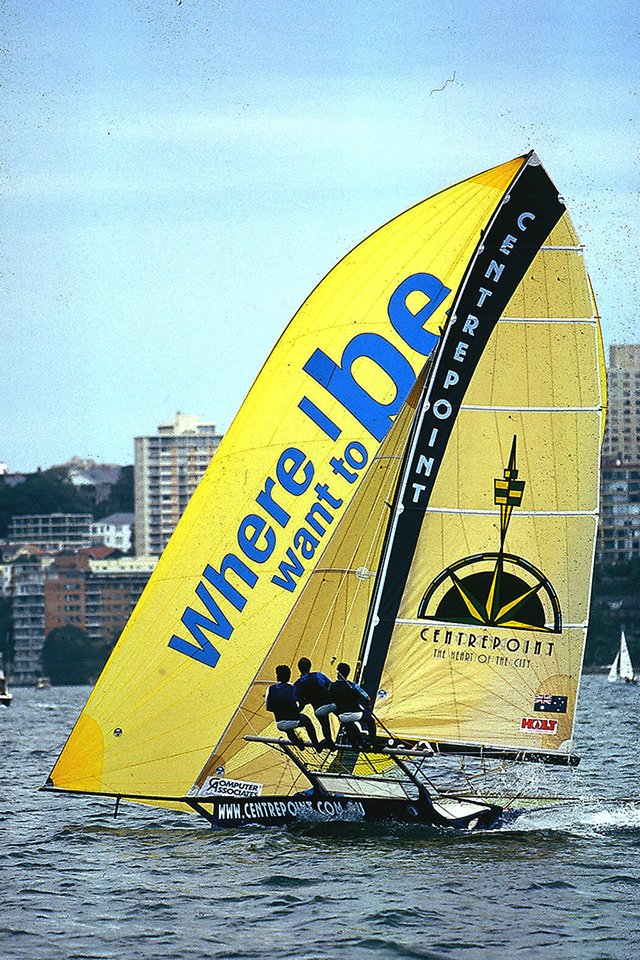With the 100th Australian 18 footers Championship scheduled to be sailed on Sydney Harbour from February 5 to 13, it’s a good opportunity to reflect on its history and acknowledge the contributions of designers, builders and competitors from NSW, Queensland and Western Australia since the first event at Perth in 1912.
Mark Foy, founder of 18-footer racing in the early 1890s, put the sport on a more national basis when he introduced a new interstate trophy, the Mark Foy Challenge Cup, at the beginning of the 1911-12 season. Following a thrilling race, Chris Garland’s Westana (WA) defeated Nimrod (NSW), by 5 seconds in front of a crowd estimated at 10,000 spectators.
The victory is regarded as the first winner on the official list of Australian Championship winners.
According to Robin Elliott’s excellent historical research (Galloping Ghosts, Australasian 18-footers 1890-1965) the 18 footers were receiving extensive media coverage, had enthusiastic patrons on ferries of all sizes, and ‘bookies’ were also there to take the bets.

Billy Dunn’s Kismet defeated Chris Webb’s Australian III the following year in Sydney, then Webb was victorious at Perth in 1913-14, which was the last contest prior to the outbreak of WW1.
Things didn’t began to get back to normal, after WW1 and the 1918-20 Spanish Flu pandemic, until Sydney’s 1920-21 championship when Queensland and WA sent boats to challenge a strong local team. Vision, from Queensland, won comfortably.
Mele Bilo gave Western Australia its second champion on the Swan River in the 1921-22 Australian Championship, but in 1928 racing 18 footers in WA disappeared, because it was claimed they had become too expensive to build and maintain.
A minimum seven foot beam had been introduced in 1910 to prevent ‘extreme’ boats, with smaller beams, being built, but Queensland voted to remove all beam restrictions and staged the 1925-26 championship with no beam restriction. NSW and WA didn’t want to legitimise the decision and no boats represented either state.
By 1930, most of the Brisbane fleet was old and numbers began to dwindle. Owners were reluctant to replace boats, due to rising costs during the Great Depression, and had difficulty maintaining big crews.
Frederick Hart was in Sydney at the 16-footer Championship in 1931-32 and claimed that Queensland could build a new style 18 footer that could beat the Sydney boats. When challenged to build this miracle boat he went back to Brisbane and commissioned Alf Whereat to build the first skiff type seven ft beam 18-footer, which he named Aberdare.
The new boat was a no heel skiff with a seven foot beam and depth of two feet. She had a lighter hull and smaller Gunter rig, and off the wind gathered great speed with mainsail, reaching jib, ringtail and peak head spinnaker. She also carried a crew of seven, compared to the 12 or 13 required on the former boats.
Aberdare contested the 1932-33 title on Sydney Harbour in a light southerly breeze which didn’t suit her smaller sail area, but she showed enough potential to impress Sydney sailors who saw her as the alternative to the ‘Big Boats’.
Up to 1932-33, all interstate championships were decided by a single race, however administrators made the decision that future championships would be a best-of-three race series.
One Sydney owner had a similar boat built and applied to have it registered at the Sydney Flying Squadron. The registration had to be granted, as there was no rule preventing the new style of boat, but once the registration was granted, the SFS voted to have them debarred, and closed its register.
At the 1933-34 championship on the Brisbane River, Aberdare showed her superiority with big wins to take the title, which led to an increasing number of Sydney enthusiasts who wanted the new style boats and were unhappy about the SFS’s decision not to compete at the 1934-35 championship.
The newly-formed NSW 18 Footers Sailing League then announced that it had made an agreement with the Brisbane Club to stage the 1934-35 Australian Championship, which became its first event on February 3, 1935.
Aberdare easily retained her title, with victories in the first and third races of the championship, then retained the title in 1935-36 and 1936-37. The latter after a tie (and no provision for a sail-off) with NSW boat, Lightning, sailed by Bert Swinbourne.
The success of the new style boat was the first step of a ‘golden era’ of Queensland 18 footer racing and the significant contribution made by its designers, builders and competitors to the development and achievements in the sport.
(When Jenny VI won the title in 1957-58, Queensland boats had won 20 of the first 36 Australian Championships staged to that time)
Queensland began to rebuild its fleet after WW2, and in 1945 decided to race six foot beam boats. The first of these six foot beamers, which were designed by Norman Wright and Lance Watts, began to sail in Brisbane in 1946.
They were cheaper to build, lighter than the previous (seven foot beam) boats, and needed a crew of only five or six, compared to the previous seven or eight, and they were fast. Most new ideas and top championship contenders were coming from the designs and sheds of Watts and Wright.
Wright saw the advantages of the ideas used on New Zealand’s champion Intrigue in the early 1950s and used them when he built Jenny VI, which was a three-layer, moulded-hull and became Queensland’s first world champion in 1956.
The Brisbane club wanted to build its fleet and asked Wright to design a cheap and easy to build hull. Bob Miller (later known as Ben Lexcen) had a sail loft in the Wright shed and a joint effort with Wright produced a totally new design.
The new boat, Taipan, was a light ply chine, two-thirds decked, with large genoa, inboard rig, no bowsprit, smaller sail area, designed for a crew of three with two on trapeze. She also had heavily flared topsides and a narrow four foot three in beam on the chine. Taipan had a smaller rig (similar to one used on a Flying Dutchman class boat) and bending spars.
Taipan immediately created dramas when Miller took the boat to Auckland for the 1960 World Championship, as the skiff was decked far in excess of the allowable area of that time, so Miller was forced to do a major reconstruction job prior to the start of the regatta, which reduced the deck by around fifty per cent.
Despite the problems experienced at Auckland, there was little doubt about the design so Miller again teamed up with Wright to build an improved version which was lighter and stronger. The new boat was named Venom, which dominated the 1961 World Championship, although it did not win an Australian title.

Sadly, it was the Queensland designers’ final impact on the 18s, but NSW legend Len Heffernan saw the potential and got the three-handers accepted by the SFS.
Unfortunately, it was too late for Heffernan to build one for the new season so he decided to go to Brisbane and bought Taipan, which he re-named Crystal Lad, and with new sails, she easily won the 1961-62 Australian Championship in Cairns, NQ.
Heffernan then spent nearly 12 months building six three-handers to the Taipan/Venom style, and got similar boats going in Sydney. He won the final two of his five Australian Championship victories (1962-63 and 1963-64) in one of them, Aberdare III.
Aberdare III was described as “a round bilge hull, with a six foot beam and 20 inches deep amidships. She was built of moulded cedar veneer, had a plywood floor, wooden fin and straight down rudder. The finished hull weighed around 150 lbs.”
“She used a 28-30’ aluminium mast, wooden booms up to 15’, and 16’-17’ aluminium spinnaker poles. Her sails were dacron or terylene, mainsail 200-250 square feet, genoa jibs 110-130 square feet, spinnakers 500-700 square feet and ringtails with up to 15’ spars.”
Schemer, a four-handed version at the League, easily won the 1963 World Championship for Ken Beashel, then the same boat, re-named as TraveLodge, gave Bob Holmes the first of his five World Championship victories when he won on Sydney Harbour in 1965.
One notable exception to the round-bilge design was the 1967-68 Australian Championship-winning Kaiser Bill, which was designed by New Zealand’s Peter Nelson. It was a hard-chine plywood three-person boat, which had only two rigs compared to three on the other boats. Her rigs were around 150 square foot less in area than the others and she was best suited in a breeze when she was able to carry her number one rig while the other boats were unable.
The 1970 decade is generally regarded as the ‘golden era’ of 18 footer racing. Large, strong fleets in the traditional areas produced some of the all-time great 18 footer champions, international competition was stronger than it had ever been, massive media coverage made boat and competitor names well-known to the general public, and it was the beginning for two future international star designers, Bruce Farr and Iain Murray.
By the end of the decade, construction had gone from the Hugh Cooke-designed 1970 World champion Thomas Cameron, which was a light weight hull, moulded in a double diagonal laminate of fine red cedar on frames of spruce and ash, to Iain Murray’s Color 7, which was built from Nomex honeycomb paper sandwiched between skins of carbon fibre and S-glass.
Thomas Cameron in 1970 had three rigs, which were designed and made by Hugh Treharne, based on knowledge he garnered while sailing Flying Dutchman dinghies. Color 7 had four rigs, designed and made by Andrew Buckland.
According to a champion skipper of the 1970s, “The three handed boats at the end of the decade were vastly superior in speed and performance than they were in the early 1970s, but there were reduced numbers of boats in all fleets due to the escalating cost of running a competitive 18ft skiff campaign.”
The 1979-80 Australian Championship in Perth produced the next great equipment change in 18 footers when Western Australia’s Richard Court introduced a sliding frame to increase leverage on his Court Yachts skiff.

John Winning and Stephen Kulmar had previously used small ‘fixed’ rails on their hulls, but the new method was so successful for Court that the top teams at the 1980 World Championship in Auckland elected to use hinged ‘wings’ for the leeward one, raised by a wire joining it to the windward one.
The 1980s design dominance belonged to Iain Murray, winning all but two Australian and two World Championships and sharing another victory with a Rob Brown design, which was highly successful during the period between 1984-85 and 1987-88.
Brown’s 1984-85 Bradmill design was the result of extensive design research and concepts and was built from a combination of strip plank balsa and carbon fibre.
According to Rob, “I travelled to Holland to test a ½ scale 18’ skiff model of my design and the introduction of the hollow in the transom of hull shape.”
“The hollow feature was a break-through in 18’ skiff designs. It involved having a hollow section in the last one-third of the hull, which generated an upward force on the hull.”
The early 1990s belonged to Julian Bethwaite’s B18 design, AAMI, which won both the JJ Giltinan world Championship and Grand Prix Sailing National Circuit but the continual rising costs and dwindling fleet numbers in all 18s racing areas caused the Australian 18 Footers League to commission Iain Murray to create a new design, with the specific intent of creating a cost effective one design hull, while maintaining the rigs and sails as areas to refine and development as new technology became available.
It became the one, and only, design accepted for racing at both the club and the JJ Giltinan world Championship and this strategy has been responsible for the current rejuvenation of the class in Australia, NZ and Europe.
Stephen Quigley, the 1996 JJ Giltinan world champion and League Director responsible for the technical development of the boats. “Since the introduction in 1993 of the one-design hull, while the underwater shape has remained unchanged, the structural laminates, internal frame layouts, deck shapes and wing strut designs have incrementally evolved in order to manage the ever increasing loads applied by the evolution of successive designs of carbon masts, spars and increasing sail areas provided by square topped, more aerodynamically efficient sails.”
“This strategy, of a rational and managed approach to technical development has allowed the 18 fleets to maintain relevance as a high-tech class at the forefront of high performance sailing .”
“Sail areas, crew weights and speeds have gradually increased with stiffer, lighter rigs and it was important that the boat structures were similarly capable of withstanding the higher dynamic loads. It is important to note that while the current skiffs are sailing with approximately 20% more sail area than a decade ago, the overall sailing weight has remained unchanged resulting in the 18’s remaining the benchmark for high energy, performance, non-foiling, skiffs.”
In Australia, the Australian 18 Footers League owns the fleet of boats, which are all built by Van Munster Boatbuilders from Kevlar Nomex honeycomb paper sandwiched between two layers of pre-preg carbon fibre. The laminated hull and deck moulds are individually baked in a custom-built oven at minimum cure cycle of 80 degrees Celsius.”
Brett Van Munster points out, “The building process is greatly refined from that used back when we began in 2006. We now use 3.5kg more carbon fibre in each hull, but the finished hull now weighs 2kg less than the originals. Laminating is done in an air conditioned, climate controlled environment and the processing of the boats and the pre-preg is also more refined these days.”
Race 7 of the NSW Championship will be sailed next Sunday.
Spectators can follow the race on board the club’s spectator ferry, however due to the COVID-19 policy, numbers are limited. Booking online through the club’s website www.18footers.com is essential. http://www.18footers.com.au/18-footers-sailing/spectator-ferry/
For those unable to make it out onto the water, the club’s live broadcast team will be on Sydney Harbour to capture all the action. Live streaming is available at www.18footers.com by clicking on the ’18 Footers TV’ link.
Follow all the club’s racing throughout the 2021-2022 Racing Season:
Club Website www.18footers.com
Twitter @18skiff
Instagram @18skiff
Facebook International 18Ft Skiff
By Frank Quealey / Australian 18 Footers League Ltd.







































